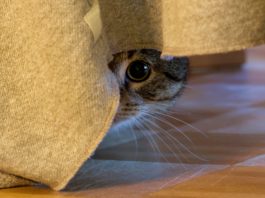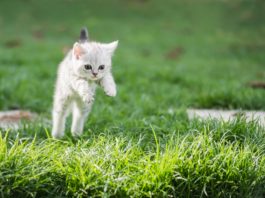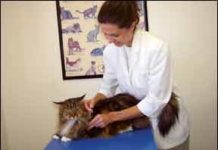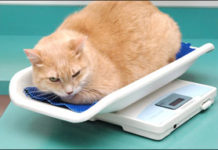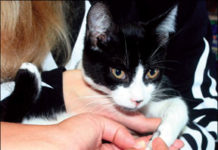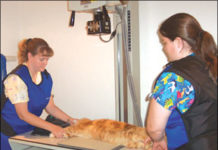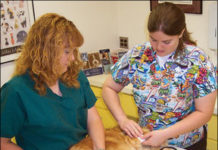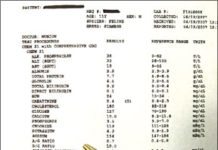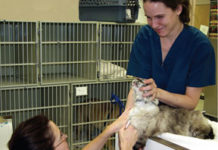Techniques and Treatments From Stem Cell Therapy to Massage
These are among the treatments that veterinarians increasingly use to improve cats well-being:
Ask Elizabeth: September 2011
Dear Elizabeth: My cat, Couscous, is 15 years old, and I know that I won’t have her here with me forever. I can’t imagine life without her dainty little paws brushing against my face in the morning as she wakes me for breakfast, or the warm, happy mews that she greets me with each time I walk in the door. I read about a company that was cloning cats. How does cloning work, and is this something that I could consider to ensure that Couscous will always be with me?
Risk of Vaccine-Associated Sarcomas
Due to the demonstrable effectiveness of vaccines in preventing a wide variety of infectious feline diseases, veterinarians used to recommend that every cat be injected every year with every available vaccine. In the past two decades or so, however, this approach to preventive therapy has come into question for several reasons.Although the vaccine safety and efficacy record is very good overall, it has now become clear that vaccination can sometimes lead to clinical disease. It is remotely possible for vaccines to damage developing fetuses in pregnant cats or to stimulate allergic reactions, and for improperly placed injections to cause severe nerve injury. And although uncommon, vaccines and the equipment used to administer them, if poorly maintained or stored, can become contaminated with infectious agents that can be transmitted by injection.
Short Takes: June 2011
Based on data in the Veterinary Medical Database (VMDB), 1,129 feline intestinal tumor patients between 1964 and 2004 were evaluated for inclusion in an epidemiologic study. Cases were analyzed by breed, age, year of diagnosis, tumor type and tumor location. (Note: Feline intestinal tumors are relatively uncommon and the incidence of all intestinal tumors for this 40-year time period was 0.4 percent.)
Feline Blood Donors: Necessary
Blood can be the gift of life not just for us, but also for our cats. "A cat suffering severe injury or trauma may require blood transfusions," says Marjory Brooks, DVM, associate director of the coagulation section at Cornell Universitys Animal Health Diagnostic Laboratory. Other indications for transfusion include surgical complications and anemia caused by autoimmune disease, renal failure, chemotherapy, parasites in the intestinal tract or fleas. "Young kittens are especially at risk for blood-loss anemia caused by flea infestation," says Dr. Brooks. Cats that need plasma proteins to combat liver disease, clotting problems or rat poisoning may also require a transfusion.
High Blood Pressure and Your Cat
As cats reach the age of eight or nine (the rough equivalent of 40 or 50 in a human), they may begin to show signs of age-related physical disorders that may or may not increase in severity as the animals continue their transition into old age. Some feline geriatric conditions, of course, may ultimately prove fatal. Others, however, may be amenable to medical therapy that can extend the life of an elderly cat for several years. Hypertension (abnormally high blood pressure) is one of the latter disorders. If untreated, it can lead to blindness and possible damage to the heart, kidneys and brain.
Feline Blood Donors: Life-Saving
Blood can be the gift of life not just for us, but also for our cats. "A cat suffering severe injury or trauma may require blood transfusions," says Marjory Brooks, DVM, associate director of the coagulation section at Cornell Universitys Animal Health Diagnostic Laboratory. Other indications for transfusion include surgical complications and anemia caused by autoimmune disease, renal failure, chemotherapy, parasites in the intestinal tract or fleas. "Young kittens are especially at risk for blood-loss anemia caused by flea infestation," explains Dr. Brooks. Cats that need plasma proteins to combat liver disease, clotting problems or rat poisoning may also require a transfusion. Qualified Donors. Just like human donors, feline donors are required to take a battery of tests prior to giving blood - and not every cat qualifies. One qualification is weight: A donor cat usually weighs from 10 to 12 pounds. "The bigger the cat, the less risk of hypotension (low blood pressure) after donation," says Dr. Brooks.
Feline Blood Disorders
The principal function of feline blood, like that of human blood, is to transport oxygen and nutrients throughout a cats body tissues and to carry carbon dioxide and various waste materials away from them. But this is by no means the only vitally necessary role that this rich, red fluid plays. Typically accounting for five percent or so of a cats total body weight, the blood is a key contributor to many other processes, such as cell development, tissue repair and the warding off of infection. The components of a cats blood are virtually identical to those of human blood, notes Marjory Brooks, DVM, associate director of the Comparative Coagulation Laboratory at Cornell Universitys College of Veterinary Medicine. These components include red cells (erythrocytes), which are critical for oxygen delivery and also assist in the removal of toxic carbon dioxide; white cells (leukocytes), which help protect an animal against infection and parasitic disease; platelets, which promote clotting and wound healing; and a colorless fluid (plasma) in which these and other life-supporting blood components - such as hormones, proteins and salts - are suspended. Disorders directly associated with blood abnormalities may not be as easily recognized by owners as other feline diseases. That does not mean that they are necessarily less serious. On the contrary, says Dr. Brooks, the diagnosis of various feline blood disorders - including low platelet counts, low red cell counts, high white cell counts, clotting problems, blood-related cancers and even blood poisonings - are a common occurrence at the Cornell University Hospital for Animals (CUHA). And the diagnosis of one of these disorders - feline anemia - is apt to occur "weekly, at least," she says.
The Musculoskeletal System
A healthy cats uniquely stunning physical traits - its power, agility and lightning-fast responses to external stimuli - are essentially attributable to its musculoskeletal system. In one way or another, this system is in operation 24 hours a day, whether a cat is hunting prey, escaping from predators, eating, drinking, napping, toying intently with a ball of yarn or digging its claws into your favorite piece of furniture. Unfortunately, cats are subject to a veritable host of disorders that can impair or totally impede the smooth operations of this impressively complex array of bones, muscles, tendons, ligaments and other tissues. Owners should be aware of the systems basic structure, various functions, and signs of its impairment, such as a noticeably altered gait, an apparent weakness in the joints, and the inability to chew and swallow food easily. As is the case with other feline disorders, says Christine Bellezza, DVM, a consultant at Cornell Universitys College of Veterinary Medicines Feline Health Center, early recognition and diagnosis of a cats musculoskeletal disorder are likely to improve the chances for its successful treatment.
Cats and High Blood Pressure
As cats reach the age of eight or nine (the rough equivalent of 40 or 50 in a human), they may begin to show signs of age-related physical disorders that may or may not increase in severity as the animals continue their transition into old age. Some feline geriatric conditions, of course, may ultimately prove fatal. Others, however, may be amenable to medical therapy that can extend the life of an elderly cat for several years. Hypertension (abnormally high blood pressure) is one of the latter disorders. If untreated, it can lead to blindness and possible damage to the heart, kidneys and brain. But given an accurate assessment of its cause and prompt initiation of appropriate veterinary treatment, the condition is most often manageable, says Richard Goldstein, DVM, an associate professor of small animal medicine at Cornell Universitys College of Veterinary Medicine who is board-certified by both the American and European Colleges of Veterinary Internal Medicine. Feline hypertension, he notes, "occurs far more frequently than people think."
What Blood Tests Tell Us
Your cats blood serves the same essential function that yours does, carrying oxygen and nutrients to tissues throughout the body and transporting carbon dioxide and wastes away from those tissues. Blood also serves in such processes as cell development, tissue repair and the warding off of infection. Considering the vital roles performed by this life-sustaining fluid, it is unlikely that any [IMGCAP(1)]veterinarian would dispute the wisdom of having your cats blood evaluated at least annually…
Feline Blood Donors
Here's what you should know about this gift of life.



